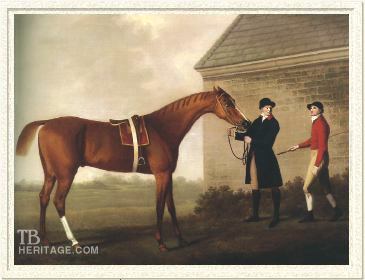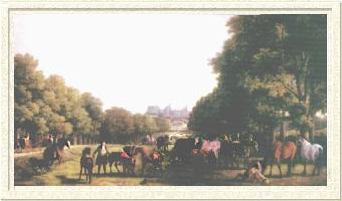|
|
Eclipse

|
|
 |
|
|
Eclipse was foaled during the great solar eclipse that occurred in
1764. His exact place of birth is unknown, but likely at the Cranborne
Lodge Stud of his breeder, H.R.H. William, the Duke of Cumberland (the
third son of Englandís King George II) in Windsor Park in Berkshire.
This is where his sire, Marske, stood at stud, having been swapped for an
Arabian by Marske's breeder John Hutton. Eclipse's dam, Spiletta, had
been purchased by the Duke from her breeder, Sir Robert Eden.
|

The Duke of Cumberland visiting his stud, c. 1764 | |
Cumberland died in 1765 and the dispersal of his bloodstock included the
flashy chestnut yearling Eclipse, purchased for 75 guineas by William
Wildman, a sheep dealer from Smithfield. Also in that sale was the
seven-year-old horse, King Herod, sold to Sir John Moore, a horse who
became known better to the world of racing simply as "Herod," and who, along
with Eclipse and Matchem, became one of the great triumvirate of early
sires.
|
Marske was sold for 20 guineas to a farmer in Dorset but after Eclipse began racing, was rescued from this obscurity by Wildman
himself, bought for 1,000 guineas. Eclipse's dam, Spiletta, became the
property of the Duke of Ancaster.
Eclipse was allowed to grow, although his temperament caused some
thought to be given to gelding him, but hard riding proved to be enough
schooling. He did not start until he was fully mature at the age of
five, after some frightening "secret" works, on May 3, 1769, winning a
plate valued at 50 pounds at Epsom in straight four-mile heats.
Supposedly, prior to the second heat, a betting man named Dennis O'Kelly
attempted to predict the finish of the race, announcing his bet "Eclipse
first, the rest nowhere." Eclipse distanced all his competitors, and
O'Kelly bought half of Eclipse for 650 guineas.
The rest of the year was a procession for the high strung chestnut. His
next two races included a two-mile heats at Ascot at the end of May, a
Kingís Plate at Winchester (4 mile heats), then he garnered two more
victories through the a lack of willing competition, resulting in walk
overs for a City Plate at Winchester and a Kingís Plate at Salisbury. He
won the City Free Plate at Salisbury (4 mile heats), then three more
Kingís Plates, at Canterbury (a walk over), Lewes, and Lichtfield. He
ended the season with nine wins in as many races.
The following year, he remained undefeated and untouchable, and as early
as April of that year, O'Kelly bought out Wildmanís remaining half
interest for 1,100 guineas. Eclipse started with a victory in a match
race against Bucephalus at Newmarket over the Beacon Course, and
followed by taking the Newmarket King's Plate (4 mile heats). He took
the King's Plate at Guildford via a walk over, another walk over in a
King's Plate at Nottingham and again at York. He then won the Great
Subscription at York, run in a single four mile "dash," followed by
another Kingís Plate at Lincoln. Moving on to the Newmarket meeting, he
won two races in two days, including the King's Plate in a walk over. In
the end, there was no more reason to race him, having proven that he was
superior to everything else in training by a wide margin, never having
been seriously challenged. He won all 18 of his starts, and was declared
the greatest runner the turf had seen since Flying Childers (a full
brother to Eclipse's own great-grandsire Bartlett's Childers, sire of
Squirt, sire of Marske.)
Eclipse retired to stud in 1771 at O'Kelly's Clay Hill Stud, near Epsom
(Surrey), initially standing for a fee of 50 guineas. In 1788, he was
relocated to Cannons Stud, Edgeware (Middlesex). Still the property of
Dennis O'Kelly, Eclipse died there as a result of colic on February 26,
1789, at the age of 24. His skeleton is now on display in the Jockey
Club Museum in Newmarket. Several of his hooves (which apparently
numbered at least five) were made into inkstands, a popular tribute at
the time. One was crafted in gold, prepared as a goblet and given to the
King of England. Hairs from his tail were further woven into the tassel
of "The Whip, supposedly Charles II's whip, and the prize of victory in
the self-named race, which must be contested for via a challenge.
Eclipse became one of the leading sires of his era, although the list
was actually dominated by Herod and his son Highflyer for many years.
His progeny were described as "light fleshed and easily trained." In
all, Eclipse sired 344 winners, including the Derby winners Young
Eclipse, Saltram, Volunteer, and Sergeant, as well as the important
runners and sires Pot-8-os, King Fergus, Mercury, Joe Andrews,
Dungannon, Alexander, Don Quixote, and Pegasus. The lines of Pot-8-os
and King Fergus survive to this day. In fact, it's estimated that among
all living Thoroughbreds, at least 95% can trace their direct tail-male
line back to Eclipse.
Only one of his daughters was a classic winner, Annette, winner of the
Oaks of 1787, but his daughters proved outstanding broodmares,
especially crossed with Herod and Highflyer, producing Phoenomenon,
Haphazard, Chanticleer, Weasel, Skyscraper, Tartar, Stamford, Archduke,
John Bull, Meteora, and Remembrancer.
Eclipse was a bright chestnut with a narrow blaze running down the
length of his face ending between his nostrils. His right hind leg was
also white almost up to his hock. Eclipse was a big horse, but
tremendously strong, sound and fast. He was never lauded for his looks
and sometimes criticized for having a large, unattractive head. His
difficult temperament was well known and he carried high weights
successfully in most of his races. Upon his death, his body was
submitted for serious medical scrutiny. His height was just over 16
hands, by half an inch, but he was notably an inch higher at the rump
than at the withers. His heart was said to be inordinately large.
--Anne Peters
|
|
|
|

